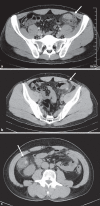The Burden of Diverticular Disease and Its Complications: West versus East
- PMID: 30733949
- PMCID: PMC6361582
- DOI: 10.1159/000492178
The Burden of Diverticular Disease and Its Complications: West versus East
Abstract
Background: Colonic diverticulosis is prevalent and increasing not only in Western but also in Asian countries. Diverticulosis can be complicated by diverticulitis and diverticular bleeding. Diverticular disease is a burdensome digestive disease, because it is a major cause of hospital admissions and is associated with significant health-care costs.
Summary: The incidence of diverticulosis increases with age. Most cases of diverticulosis in Western countries involve the left side of the colon, while diverticulosis is predominantly present on the right side of the colon in Asian countries. The incidence of diverticulitis also increases with age. Diverticulitis is predominantly located on the left side of the colon in Western countries, while it is predominantly located on the right side of the colon in Asian countries. The overall complication rate is higher in left-sided than in right-sided diverticulitis. The incidence of diverticular bleeding also increases with age. The right colon is the source of diverticular bleeding in more than 50% of patients in Western countries. In Asian countries, age greater than 70 years and both-sided diverticulosis increase the bleeding risk.
Key messages: In Western countries, diverticulosis and diverticulitis are predominantly located on the left side of the colon, whereas they are predominantly present on the right side of the colon in Asian countries. Diverticular bleeding is predominantly located on the right side in Western countries, and both-sided diverticulosis increases the risk of bleeding in Asian countries. Diverticular disease with complications requires admission and operation; moreover, it recurs frequently. Therefore, diverticular disease is associated with a significant economic burden in terms of health-care costs and resource utilization.
Keywords: Diverticular bleeding; Diverticulitis; Diverticulosis; East; West.
Figures


References
-
- Yamamichi N, Shimamoto T, Takahashi Y, Sakaguchi Y, Kakimoto H, Matsuda R, Kataoka Y, Saito I, Tsuji Y, Yakabi S, Takeuchi C, Minatsuki C, Niimi K, Asada-Hirayama I, Nakayama C, Ono S, Kodashima S, Yamaguchi D, Fujishiro M, Yamaji Y, Wada R, Mitsushima T, Koike K. Trend and risk factors of diverticulosis in Japan: age, gender, and lifestyle/metabolic-related factors may cooperatively affect on the colorectal diverticula formation. PLoS One. 2015;10:e0123688. - PMC - PubMed
-
- Nagata N, Niikura R, Aoki T, Shimbo T, Itoh T, Goda Y, Suda R, Yano H, Akiyama J, Yanase M, Mizokami M, Uemura N. Increase in colonic diverticulosis and diverticular hemorrhage in an aging society: lessons from a 9-year colonoscopic study of 28,192 patients in Japan. Int J Colorectal Dis. 2014;29:379–385. - PubMed
-
- Acosta JA, Grebenc ML, Doberneck RC, McCarthy JD, Fry DE. Colonic diverticular disease in patients 40 years old or younger. Am Surg. 1992;58:605–607. - PubMed
-
- Niikura R, Nagata N, Shimbo T, Aoki T, Yamada A, Hirata Y, Sekine K, Okubo H, Watanabe K, Sakurai T, Yokoi C, Mizokami M, Yanase M, Akiyama J, Koike K, Uemura N. Natural history of bleeding risk in colonic diverticulosis patients: a long-term colonoscopy-based cohort study. Aliment Pharmacol Ther. 2015;41:888–889. - PubMed
Publication types
LinkOut - more resources
Full Text Sources

